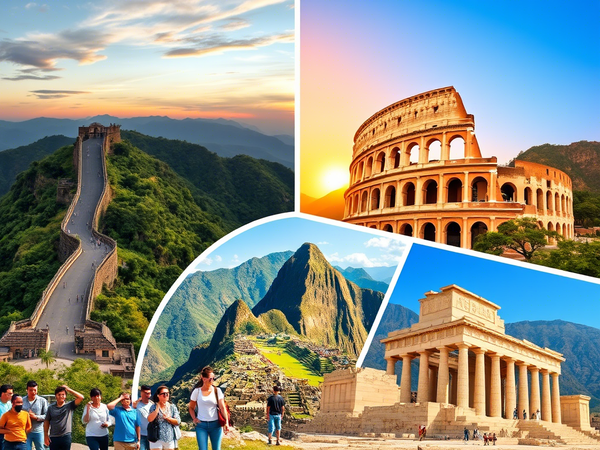5 Unforgettable Cultural Celebrations to Experience Globally
5 Historical Sites Every History Buff Should Visit

History can be discovered in buildings, historic sites, and cities that have changed over time, in addition to books. The best way to feel connected to history is to visit notable historical sites. From ancient empires to battlegrounds, these five locations allow history buffs to experience the past.
The Colosseum – Rome, Italy
A prominent historical site that history buffs just must see is Rome's Colosseum. This stadium, the largest in its day, was built in 80 AD by Emperor Titus and held 50,000–80,000. The Colosseum was built for public entertainment. It included exciting things like gladiator combats, animal hunting, and naval simulations of war. Instead of using these occasions for amusement, emperors utilized them to demonstrate Roman might and win over the populace.
The Colosseum's innovative architectural design is what sets it apart. The hypogeum was a complex system of underground tunnels and caves that were situated beneath the surface of the earth. It allowed wild creatures and gladiators to enter in novel and surprising ways. To protect spectators from the sun, the arena had an adjustable roof known as the velarium. People's seating arrangements were influenced by their social standing.
Poorer individuals sat in the higher rows, while the wealthy had the best seats. This demonstrated the glaring disparities in class throughout Roman society. Earthquakes and individuals who stole its stones have damaged the Colosseum over the years. It is nevertheless visited by millions yearly and is superbly preserved.
A clear window into the past is offered by today's tours, which include stops at the reconstructed arena floor and underground rooms. Rome's continuing power throughout history is demonstrated by the Colosseum, which stands as a symbol of its might and global influence on architecture, politics, and entertainment. History buffs learn about the social relationships, power structures, and way of life of a great civilization.
Machu Picchu – Peru
Machu Picchu sits way up in Peru's Andes Mountains. It demonstrates how highly developed the Inca civilization's architecture and culture were. Built during the reign of Emperor Pachacuti in the 1400s, Machu Picchu was unknown until 1911, when historian Hiram Bingham revealed it. Machu Picchu is an impressive and well-chosen location.
It is encircled by gorgeous green hills and sits in the mountains at an elevation of almost 8,000 feet. It was either a royal home, a house of worship, or possibly both, according to experts. These temples are aligned with divine occurrences, and steps were built on the hillside to help with agriculture and avoid erosion. Machu Picchu's meticulous stonework is what sets it apart. Ashlar masonry was a method practiced by the Incas for building their buildings.
Using this technique, stones are firmly formed to fit precisely without the need for cement, leaving no room for a knife blade. These structures have stood for hundreds of years despite the region's frequent earthquakes. More than 150 stone structures, including temples, residences, and ceremonial spaces, are visible to visitors to Machu Picchu.
Following a trek through cloud forests and Incan structures, the Inca Trail reaches its peak at the Sun Gate, from which the citadel can be viewed. Without the use of writing or a wheel, Machu Picchu displays the cultural and technological achievements of an amazing ancient civilization. A UNESCO World Heritage Site that offers a singular and motivating experience by blending nature and history.
Petra – Jordan
Carved into pink sandstone cliffs, Petra is a breathtaking archeological site. It is among the world's most well-known historical sites. From 400 BC to 106 AD, the "Rose City" flourished as the vibrant capital of the Nabataean Kingdom. Because of its advantageous location along important trade routes that connected the East and West, the city prospered.
The most famous structure in Petra is Al-Khazneh, popularly known as "The Treasury." It is about 40 meters high and features a Greco-Roman-style facade that is exquisitely sculpted. The city is home to more than 800 landmarks, including neighborhoods, a theater, temples, and cemeteries etched into the rock. The Nabataeans had excellent construction and labor skills. They developed a clever water management system that allowed them to survive successfully in the desert.
Petra was hidden from the Western world for years until it was discovered in 1812 by Swiss explorer Johann Ludwig Burckhardt. As one of the New Seven Wonders of the World and a UNESCO World Heritage site, it welcomes visitors from around the globe. It is as if time travel is possible as you walk through the Siq, a narrow, twisting ravine leading to the city.
Even the most experienced travelers are shocked at the Treasury's beauty as it comes into view. A confluence of influences, the building styles of the city reflect a blending of businesses and cultures. Petra is considered by history enthusiasts to be a living museum that reflects human creativity, religion, and ancient commerce. A community showed strength and resourcefulness by building houses out of stones in a hostile desert, forming a strong community.
Angkor Wat - Cambodia
Angkor Wat, which is located deep in the Cambodian jungle, is Southeast Asia's largest religious complex with enormous historical significance. In the early 1100s, King Suriyavarman II built Angkor Wat as a temple dedicated to Vishnu. It slowly evolved into a Buddhist complex, demonstrating how the region's religion has progressed. The temple is located in the middle of the large Angkor Archaeological Park, which has many buildings from the Khmer Empire.
Angkor Wat shows the usual Khmer architectural layout skillfully. The large, well-proportioned temple boasts stunning carvings of well-known Hindu stories like the Ramayana and Mahabharata. In Hindu myth, the surrounding walkway of a temple is Mount Meru, and one spire stands for one peak of this divine mountain. The work and art that went into building Angkor are incredible.
They used large, heavy pieces of sandstone that were brought from distant quarries many kilometers away. With decades of usage and having weathered it through, Angkor Wat remains standing and strong, and continues to be used for religious purposes. As the sun rises, the water lily-covered temple in a wonderful form is a sight that travelers will never forget.
For history lovers, Angkor Wat offers a glimpse into the politics, religion, and artistry of the Khmer Empire. Mythological tales are blended with construction techniques, evidencing belief in corridors and statues. Angkor Wat provides a strong connection to a large, old society via politics, religions, and grand buildings.
The Acropolis - Athens, Greece
The Acropolis overlooks the city of Athens today. It shows the ancient Greek civilization and its lasting impact on philosophy, politics, and the arts. One of the significant buildings of the ancient fortification, dating from the fifth century BC, is the Parthenon, a temple to Athena, the guardian goddess of the city. Pericles presided over the building of the Parthenon, a grand specimen of Doric architecture at Athens' Golden Age.
The Greeks' superior design skills are evident in their beautiful designs, such as curving columns and beautiful ornamentation. The Temple of Athena Nike, symbolizing victory, and the Erechtheion, which contains statues of women called Caryatids, are both included in the Acropolis. Aside from its religious and cultural importance, the Acropolis was also a powerful political symbol.
The wealth, power, and commitment to ideals of the city-state would leave an enduring influence on Western civilization. Even after being ravaged by earthquakes, invasions, and a massive explosion during the 17th century, the beauty of the site has largely been preserved through restoration. The adjacent Acropolis Museum houses most of the original statues and artifacts that had been taken out for preservation.
Climbing to the Acropolis provides stunning vistas of Athens and leads you to consider the origin of philosophy, drama, and democracy. The Acropolis is fascinating to history enthusiasts because it is not just ancient buildings; it is a symbol of a culture that still influences the world today. Weathered steps, carved designs, and marble pillars speak of a civilization that reposes in reason, beauty, and friendship.
Conclusion
Apart from being beautiful, these ancient sites also tell us about the thoughts, principles, and lifestyles of the early inhabitants. History comes alive when Rome, Inca mysteries, Nabataean masterpieces, Khmer faith, and Greek wisdom are explored.
A journey through numerous times, civilizations, and achievements awaits history enthusiasts visiting these places. Even when empires collapse, their stories continue to live on, motivating and teaching future generations.








